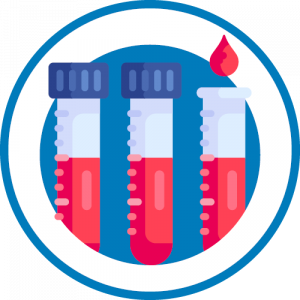For Participants
Blood Collection

Starting in 2025, the Study will seek around 3,000 OHS participants to provide a second blood sample. This will help researchers learn more about chronic diseases like cancer, heart disease, and diabetes. By studying these new samples along with earlier ones, and with survey data and other records, researchers can get a clearer picture of your health. Having multiple samples from the same person also helps in studying changes in the blood over time, including early signs of disease, called biomarkers.
The Study previously invited selected participants who were between the ages of 30-74 when they completed the OHS questionnaire to also provide a blood sample. By March 31st 2017, the OHS collected over 40,000 Blood samples, which enhanced the data already given by participants, and allowed participants to learn something that they did not know about their health.
On this page you will find information about:
What We Do With Your Blood Sample
Participants providing a second blood sample to the OHS will have 6 tubes (approximately 44mL or ~2.5 tablespoons) of blood taken from a vein in their arm.
Most of each blood sample will be frozen so that researchers can use some of it in the future. A portion of the blood will be used for immediate analysis. A report with up to 15 of the results from the immediate blood analysis will be shared with participants on their OHS account.
These analyses include:
- Glycosylated Hemoglobin (HbA1c) Analysis: This test measures the long-term level of sugar in your blood, and is used to detect and monitor cases of diabetes. This test will help health researchers study diabetes, heart disease and obesity.
- Complete Blood Count: This test analyzes the cells in your blood to look for anemia, infection and other diseases. This test gives a general indication of your health. (Click to see all individual results)
- White Blood Cell (WBC) Count: White blood cells make up part of the immune system and help the body fight infection and certain diseases.
- Neutrophil Count: The most common type of white blood cell.
- Lymphocyte Count: A type of white blood cell.
- Monocyte Count: The largest type of white blood cell.
- Eosinophil Count: A type of white blood cell.
- Red Blood Cell Count: Red blood cells carry oxygen throughout the body.
- Hemoglobin: A component of red blood cells, hemoglobin delivers oxygen from the lungs throughout the body.
- Hematocrit: Hematocrit is the amount of red blood cells in the blood.
- Mean Corpuscular Volume: A measurement of the average size of your red blood cells.
- Mean Corpuscular Hemoglobin: A measurement of the amount of hemoglobin in your red blood cells.
- Mean Corpuscular Hemoglobin Concentration: The average amount of hemoglobin in your red blood cells, relative to their volume.
- Platelet Count: Platelets form clots in the blood, which can stop or prevent bleeding.
- Red Cell Distribution Width Test: This test is used to help diagnose anemia, where red blood cells can’t carry enough oxygen.
- Basophil Count: Basophils defend against allergens, infections, blood clotting, and parasites.
- Reticulocyte Count: Reticulocytes are immature red blood cells and are found in your bone marrow.
Protecting Your Privacy
We know how important it is to keep information about your health private and confidential. When samples are processed and stored for future research, anything that personally identifies you, such as your name, will be removed and replaced with a unique code. This unique code will let us link you to the sample you have provided while allowing us to keep your identity confidential. Only a handful of staff at the Ontario Health Study have access to the electronic key that matches your unique code to your identity.
Your coded information is encrypted, or “scrambled,” before it is transferred to our data centre. Coded information is only transferred over secure connections similar to those used for online banking. These secure connections are very difficult for outsiders to breach. The coded information is then stored on encrypted servers (very large computers) in a locked room that very few people can access. We only unscramble the information after it has safely arrived on our servers. The information you provide related to your blood sample will be stored on a separate server from your questionnaire responses or anything that personally identifies you (e.g., name, address, OHIP number).
Access to Data
All blood test results are de-identified and stored on secure servers at the Ontario Health Study. Access to the data and samples is governed by strict guidelines that protect the confidentiality of participants:
- All health researchers using data from the Study must receive approval from a Research Ethics Board or similar committee before access is given.
- No information about you will be given to your employer, family members or insurance companies.
- All blood samples will be given a unique code and no personal information will be kept on tubes that store blood samples. Samples are processed at accredited laboratories and stored in repositories located in Canada.
